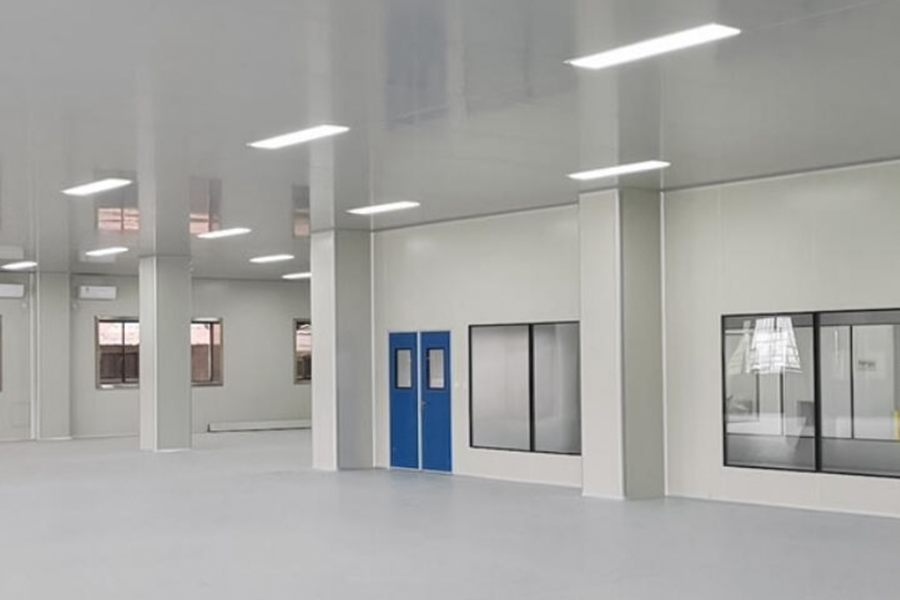

The airflow organization of a clean room is significant […]
The airflow organization of a clean room is significantly different from that of a general air-conditioned room, because not only the requirements for maintaining indoor temperature and humidity, but also the diffusion of indoor pollution sources and the requirements for maintaining the cleanliness of the production environment must be considered. There are three basic types of basic airflow patterns: unidirectional flow, non-unidirectional flow, and mixed flow.
One-way flow: It flows smoothly from the air supply side of the room to the corresponding return air side. One-way flow can ensure better indoor cleanliness, but the project cost is high and the operating cost is also high. Generally used in clean rooms with air cleanliness class 1 to 5. Such as: pharmacies, hospitals, operating rooms and other places.
1. The non-unidirectional flow pattern is a non-uniform airflow distribution method, and its speed direction is different at different points in the clean room. It is a form that is often used in practical applications. Generally, the supply and return air outlets are set to make up for the phenomenon of uneven air distribution. It is generally used in places where the air cleanliness class is 6 to 9.
2. The air flow that combines non-unidirectional flow and unidirectional flow in the same clean room is a mixed flow. Generally, unidirectional flow is used for parts that require strict air cleanliness in the room, and non-unidirectional flow is used for others. The type can save the engineering cost, and can meet the local requirements of high cleanliness.
3. The clean room should be considered to maintain a certain pressure difference in the room during the engineering design, and maintain a positive pressure difference in an industrial clean room and a natural scenery place, but maintain a negative pressure difference for spaces with high pollution such as toxic and harmful gases. The "Code for Design of Clean Workshop" requires that the pressure difference between clean rooms of different grades and the non-clean area and the clean area should be less than 5 Pa, and the pressure difference between the clean room and the outside should not be less than 10 Pa. In the project, the air supply volume to maintain the pressure difference is usually estimated by the method of the number of air changes: the number of air changes is generally determined according to the following empirical data.
①. When the differential pressure value is 5 Pa, the ventilation times corresponding to the differential pressure air volume is 1~2h -1
②. When the differential pressure value is 10 Pa, the corresponding ventilation times of the differential pressure air volume is 2~4h -1

In simple terms, a cleanroom is a controlled area within a wider facility that maintains a specific level of air particles and other contaminants. The three ways in which a cleanroom is clean are: The air quality is controlled. All surfaces and equipment are always cleaned to a certain standard.
Cleanroom Classifications:Pharmacy Cleanroom
Cleanrooms provide an enclosed environment with controlled levels of particulate matter (such as dust, vapours and airborne particles). Establishing a cleanroom involves a number of steps including engineering, manufacturing and control strategies. While they are used for a range of medical, scientific and manufacturing applications, we will provide a brief overview of cleanrooms used for pharmaceutical applications that do not handle potent chemicals or hazardous organisms.
Depending on the type of pharmaceutical product you manufacture and federal standards, you may or may not need a cleanroom. A clean area ventilated with filtered air can be used as an alternative to a clean room when producing non-sterile products. You should define your clean zone or cleanroom standards and procedures according to federal standards (e.g. US FED209E) or international standards (e.g. ISO 14644-1 and ISO 14698). For sterile pharmaceutical products, cleanrooms are required to limit airborne particles and contamination from pharmaceutical products. The standards and requirements of a cleanroom are based on its classification and it is important that a room is properly classified as operators need to comply with all requirements and maintain the cleanliness standards for a given classification during operation.
Our new models offer superb design;competitive prices and their new features give them distinct advantages over similar products from other manufacturers.